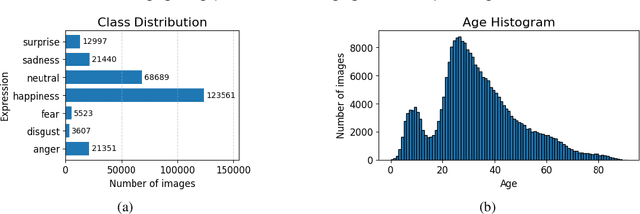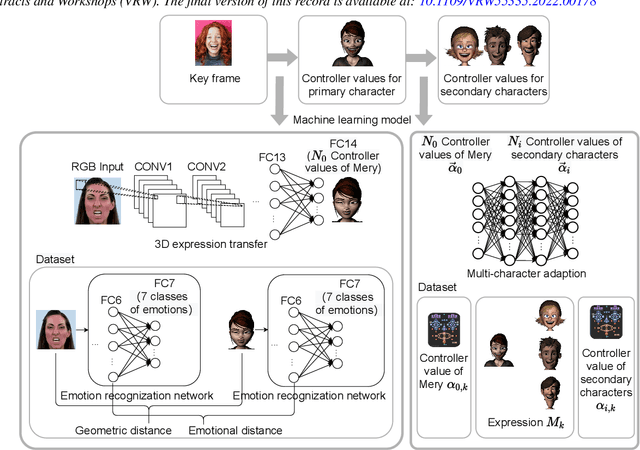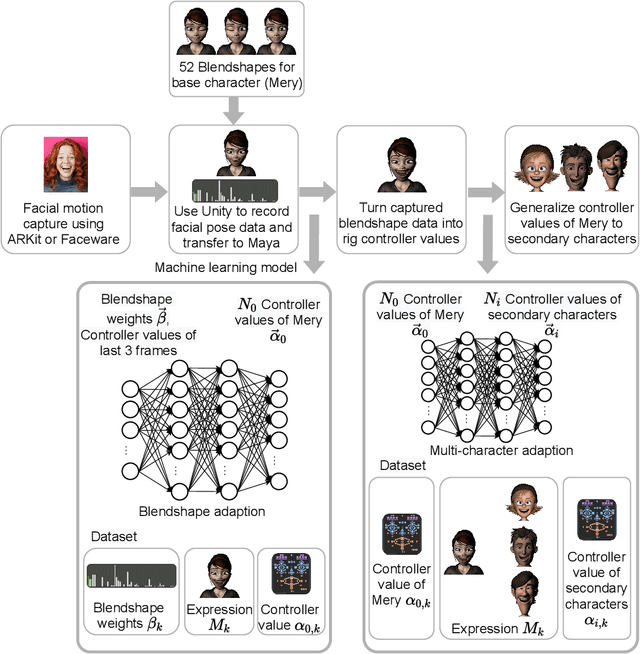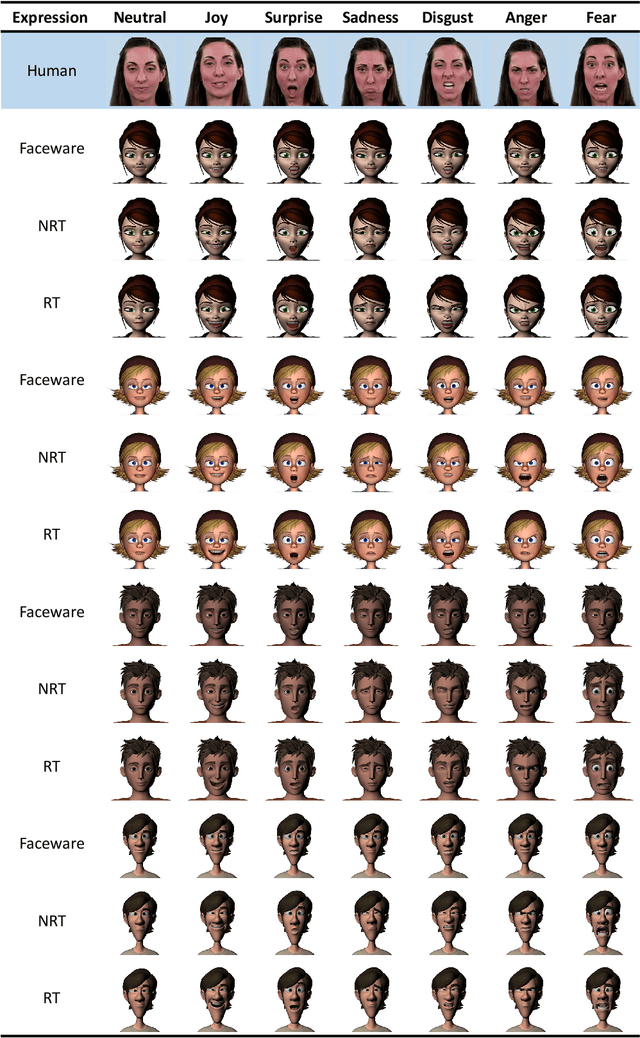facial recognition
Facial recognition is an AI-based technique for identifying or confirming an individual's identity using their face. It maps facial features from an image or video and then compares the information with a collection of known faces to find a match.
Papers and Code
Bridging the gap in FER: addressing age bias in deep learning
Jul 10, 2025



Facial Expression Recognition (FER) systems based on deep learning have achieved impressive performance in recent years. However, these models often exhibit demographic biases, particularly with respect to age, which can compromise their fairness and reliability. In this work, we present a comprehensive study of age-related bias in deep FER models, with a particular focus on the elderly population. We first investigate whether recognition performance varies across age groups, which expressions are most affected, and whether model attention differs depending on age. Using Explainable AI (XAI) techniques, we identify systematic disparities in expression recognition and attention patterns, especially for "neutral", "sadness", and "anger" in elderly individuals. Based on these findings, we propose and evaluate three bias mitigation strategies: Multi-task Learning, Multi-modal Input, and Age-weighted Loss. Our models are trained on a large-scale dataset, AffectNet, with automatically estimated age labels and validated on balanced benchmark datasets that include underrepresented age groups. Results show consistent improvements in recognition accuracy for elderly individuals, particularly for the most error-prone expressions. Saliency heatmap analysis reveals that models trained with age-aware strategies attend to more relevant facial regions for each age group, helping to explain the observed improvements. These findings suggest that age-related bias in FER can be effectively mitigated using simple training modifications, and that even approximate demographic labels can be valuable for promoting fairness in large-scale affective computing systems.
Autonomous AI Surveillance: Multimodal Deep Learning for Cognitive and Behavioral Monitoring
Jul 02, 2025This study presents a novel classroom surveillance system that integrates multiple modalities, including drowsiness, tracking of mobile phone usage, and face recognition,to assess student attentiveness with enhanced precision.The system leverages the YOLOv8 model to detect both mobile phone and sleep usage,(Ghatge et al., 2024) while facial recognition is achieved through LResNet Occ FC body tracking using YOLO and MTCNN.(Durai et al., 2024) These models work in synergy to provide comprehensive, real-time monitoring, offering insights into student engagement and behavior.(S et al., 2023) The framework is trained on specialized datasets, such as the RMFD dataset for face recognition and a Roboflow dataset for mobile phone detection. The extensive evaluation of the system shows promising results. Sleep detection achieves 97. 42% mAP@50, face recognition achieves 86. 45% validation accuracy and mobile phone detection reach 85. 89% mAP@50. The system is implemented within a core PHP web application and utilizes ESP32-CAM hardware for seamless data capture.(Neto et al., 2024) This integrated approach not only enhances classroom monitoring, but also ensures automatic attendance recording via face recognition as students remain seated in the classroom, offering scalability for diverse educational environments.(Banada,2025)
CAST-Phys: Contactless Affective States Through Physiological signals Database
Jul 08, 2025In recent years, affective computing and its applications have become a fast-growing research topic. Despite significant advancements, the lack of affective multi-modal datasets remains a major bottleneck in developing accurate emotion recognition systems. Furthermore, the use of contact-based devices during emotion elicitation often unintentionally influences the emotional experience, reducing or altering the genuine spontaneous emotional response. This limitation highlights the need for methods capable of extracting affective cues from multiple modalities without physical contact, such as remote physiological emotion recognition. To address this, we present the Contactless Affective States Through Physiological Signals Database (CAST-Phys), a novel high-quality dataset explicitly designed for multi-modal remote physiological emotion recognition using facial and physiological cues. The dataset includes diverse physiological signals, such as photoplethysmography (PPG), electrodermal activity (EDA), and respiration rate (RR), alongside high-resolution uncompressed facial video recordings, enabling the potential for remote signal recovery. Our analysis highlights the crucial role of physiological signals in realistic scenarios where facial expressions alone may not provide sufficient emotional information. Furthermore, we demonstrate the potential of remote multi-modal emotion recognition by evaluating the impact of individual and fused modalities, showcasing its effectiveness in advancing contactless emotion recognition technologies.
Touch Speaks, Sound Feels: A Multimodal Approach to Affective and Social Touch from Robots to Humans
Aug 11, 2025Affective tactile interaction constitutes a fundamental component of human communication. In natural human-human encounters, touch is seldom experienced in isolation; rather, it is inherently multisensory. Individuals not only perceive the physical sensation of touch but also register the accompanying auditory cues generated through contact. The integration of haptic and auditory information forms a rich and nuanced channel for emotional expression. While extensive research has examined how robots convey emotions through facial expressions and speech, their capacity to communicate social gestures and emotions via touch remains largely underexplored. To address this gap, we developed a multimodal interaction system incorporating a 5*5 grid of 25 vibration motors synchronized with audio playback, enabling robots to deliver combined haptic-audio stimuli. In an experiment involving 32 Chinese participants, ten emotions and six social gestures were presented through vibration, sound, or their combination. Participants rated each stimulus on arousal and valence scales. The results revealed that (1) the combined haptic-audio modality significantly enhanced decoding accuracy compared to single modalities; (2) each individual channel-vibration or sound-effectively supported certain emotions recognition, with distinct advantages depending on the emotional expression; and (3) gestures alone were generally insufficient for conveying clearly distinguishable emotions. These findings underscore the importance of multisensory integration in affective human-robot interaction and highlight the complementary roles of haptic and auditory cues in enhancing emotional communication.
Learning Personalised Human Internal Cognition from External Expressive Behaviours for Real Personality Recognition
Jul 31, 2025



Automatic real personality recognition (RPR) aims to evaluate human real personality traits from their expressive behaviours. However, most existing solutions generally act as external observers to infer observers' personality impressions based on target individuals' expressive behaviours, which significantly deviate from their real personalities and consistently lead to inferior recognition performance. Inspired by the association between real personality and human internal cognition underlying the generation of expressive behaviours, we propose a novel RPR approach that efficiently simulates personalised internal cognition from easy-accessible external short audio-visual behaviours expressed by the target individual. The simulated personalised cognition, represented as a set of network weights that enforce the personalised network to reproduce the individual-specific facial reactions, is further encoded as a novel graph containing two-dimensional node and edge feature matrices, with a novel 2D Graph Neural Network (2D-GNN) proposed for inferring real personality traits from it. To simulate real personality-related cognition, an end-to-end strategy is designed to jointly train our cognition simulation, 2D graph construction, and personality recognition modules.
Multimodal Prompt Alignment for Facial Expression Recognition
Jun 26, 2025Prompt learning has been widely adopted to efficiently adapt vision-language models (VLMs) like CLIP for various downstream tasks. Despite their success, current VLM-based facial expression recognition (FER) methods struggle to capture fine-grained textual-visual relationships, which are essential for distinguishing subtle differences between facial expressions. To address this challenge, we propose a multimodal prompt alignment framework for FER, called MPA-FER, that provides fine-grained semantic guidance to the learning process of prompted visual features, resulting in more precise and interpretable representations. Specifically, we introduce a multi-granularity hard prompt generation strategy that utilizes a large language model (LLM) like ChatGPT to generate detailed descriptions for each facial expression. The LLM-based external knowledge is injected into the soft prompts by minimizing the feature discrepancy between the soft prompts and the hard prompts. To preserve the generalization abilities of the pretrained CLIP model, our approach incorporates prototype-guided visual feature alignment, ensuring that the prompted visual features from the frozen image encoder align closely with class-specific prototypes. Additionally, we propose a cross-modal global-local alignment module that focuses on expression-relevant facial features, further improving the alignment between textual and visual features. Extensive experiments demonstrate our framework outperforms state-of-the-art methods on three FER benchmark datasets, while retaining the benefits of the pretrained model and minimizing computational costs.
MienCap: Realtime Performance-Based Facial Animation with Live Mood Dynamics
Aug 06, 2025



Our purpose is to improve performance-based animation which can drive believable 3D stylized characters that are truly perceptual. By combining traditional blendshape animation techniques with multiple machine learning models, we present both non-real time and real time solutions which drive character expressions in a geometrically consistent and perceptually valid way. For the non-real time system, we propose a 3D emotion transfer network makes use of a 2D human image to generate a stylized 3D rig parameters. For the real time system, we propose a blendshape adaption network which generates the character rig parameter motions with geometric consistency and temporally stability. We demonstrate the effectiveness of our system by comparing to a commercial product Faceware. Results reveal that ratings of the recognition, intensity, and attractiveness of expressions depicted for animated characters via our systems are statistically higher than Faceware. Our results may be implemented into the animation pipeline, and provide animators with a system for creating the expressions they wish to use more quickly and accurately.
Reading Smiles: Proxy Bias in Foundation Models for Facial Emotion Recognition
Jun 23, 2025Foundation Models (FMs) are rapidly transforming Affective Computing (AC), with Vision Language Models (VLMs) now capable of recognising emotions in zero shot settings. This paper probes a critical but underexplored question: what visual cues do these models rely on to infer affect, and are these cues psychologically grounded or superficially learnt? We benchmark varying scale VLMs on a teeth annotated subset of AffectNet dataset and find consistent performance shifts depending on the presence of visible teeth. Through structured introspection of, the best-performing model, i.e., GPT-4o, we show that facial attributes like eyebrow position drive much of its affective reasoning, revealing a high degree of internal consistency in its valence-arousal predictions. These patterns highlight the emergent nature of FMs behaviour, but also reveal risks: shortcut learning, bias, and fairness issues especially in sensitive domains like mental health and education.
VisualSpeaker: Visually-Guided 3D Avatar Lip Synthesis
Jul 08, 2025Realistic, high-fidelity 3D facial animations are crucial for expressive avatar systems in human-computer interaction and accessibility. Although prior methods show promising quality, their reliance on the mesh domain limits their ability to fully leverage the rapid visual innovations seen in 2D computer vision and graphics. We propose VisualSpeaker, a novel method that bridges this gap using photorealistic differentiable rendering, supervised by visual speech recognition, for improved 3D facial animation. Our contribution is a perceptual lip-reading loss, derived by passing photorealistic 3D Gaussian Splatting avatar renders through a pre-trained Visual Automatic Speech Recognition model during training. Evaluation on the MEAD dataset demonstrates that VisualSpeaker improves both the standard Lip Vertex Error metric by 56.1% and the perceptual quality of the generated animations, while retaining the controllability of mesh-driven animation. This perceptual focus naturally supports accurate mouthings, essential cues that disambiguate similar manual signs in sign language avatars.
OPEN: A Benchmark Dataset and Baseline for Older Adult Patient Engagement Recognition in Virtual Rehabilitation Learning Environments
Jul 23, 2025Engagement in virtual learning is essential for participant satisfaction, performance, and adherence, particularly in online education and virtual rehabilitation, where interactive communication plays a key role. Yet, accurately measuring engagement in virtual group settings remains a challenge. There is increasing interest in using artificial intelligence (AI) for large-scale, real-world, automated engagement recognition. While engagement has been widely studied in younger academic populations, research and datasets focused on older adults in virtual and telehealth learning settings remain limited. Existing methods often neglect contextual relevance and the longitudinal nature of engagement across sessions. This paper introduces OPEN (Older adult Patient ENgagement), a novel dataset supporting AI-driven engagement recognition. It was collected from eleven older adults participating in weekly virtual group learning sessions over six weeks as part of cardiac rehabilitation, producing over 35 hours of data, making it the largest dataset of its kind. To protect privacy, raw video is withheld; instead, the released data include facial, hand, and body joint landmarks, along with affective and behavioral features extracted from video. Annotations include binary engagement states, affective and behavioral labels, and context-type indicators, such as whether the instructor addressed the group or an individual. The dataset offers versions with 5-, 10-, 30-second, and variable-length samples. To demonstrate utility, multiple machine learning and deep learning models were trained, achieving engagement recognition accuracy of up to 81 percent. OPEN provides a scalable foundation for personalized engagement modeling in aging populations and contributes to broader engagement recognition research.
 Add to Chrome
Add to Chrome Add to Firefox
Add to Firefox Add to Edge
Add to Edge